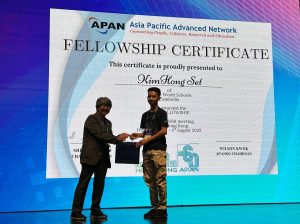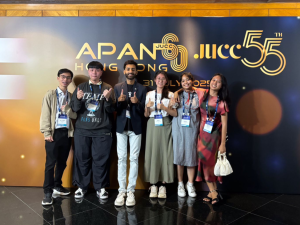I am deeply honored to have been selected as a fellow for APAN 58, alongside four of my brilliant colleagues from Machine Vision and Intelligent Systems Lab at NUST. Under the insightful guidance of Prof. Dr. Muhammad Moazam Fraz, we had the privilege of representing our lab at this prestigious event. This opportunity not only allowed us to showcase our research in machine vision and artificial intelligence but also fostered a deeper connection with the global community dedicated to advanced networking and computing technologies.
Agriculture Working Group (AgWG) & Rural Hybridization
One of the sessions that left a lasting impression on me was the Agriculture Working Group (AgWG) & Rural Hybridization session. I had the honor of interacting with Sir Mitsuru Kameya from Japan’s Ministry of Agriculture, Forestry, and Fisheries (MAFF). His presentation on Japan’s recent policies for agricultural production using ICT technology was enlightening. We exchanged views on good agricultural practices, comparing the approaches between Japan and Pakistan. The discussions centered around the application of IoT and web services in agriculture, which are being used to revolutionize farming practices. This session expanded my understanding of how technology can be leveraged to enhance agricultural production and sustainability. I look forward to fostering collaborations in this area to explore further innovations between Pakistan and Japan.
Generative AI and Its Transformative Impact
Another highlight was the keynote session by Dr. Agha Ali Raza from LUMS, titled Demystifying Generative AI. He presented the complexities of artificial intelligence in a way that was accessible to everyone. One example that stood out was his explanation of how AI can learn from data to generate new content, whether it be images, text, or video. He illustrated this with a video on synthetic reality and AI-generated content, and even took us through the concept of prompt engineering, showing how detailed instructions could result in vastly different outcomes. This session ignited my curiosity, especially regarding the potential of AI in generating solutions that can be applied across industries.
I also attended the insightful session on Generative AI for NREN Empowerment by Asitha Bandaranayake, where the focus was on how GenAI can assist beginners in sharing knowledge with experts and contribute to a global community. His discussion on transformer-based models, VAEs, and GANs opened my eyes to the technical depth of AI and how it can empower networks like NREN.
Exploring Global Connectivity and Collaboration
The session on eduroam, presented by my fellow delegate Tuwan A Jaleel, was particularly enlightening. His insights on the roaming capabilities of eduroam and its implementation in Sri Lanka highlighted the practical steps that countries can take to advance their networking capabilities. It’s encouraging to see how such technologies can foster greater academic collaboration globally.
Engaging with the APAN Community
Beyond the sessions, I had the incredible opportunity to interact with APAN organizers, such as Liana Jacinta and Shaan Bin Sivagurunathan, as well as esteemed members of the Higher Education Commission (HEC) and other brilliant fellows from diverse backgrounds. These interactions enriched my overall experience, and I left the event with a renewed sense of purpose and a network of inspiring professionals.
Looking Forward: Applying My Learning
Attending APAN 58 has been a transformative experience. I not only deepened my understanding of cutting-edge technologies but also explored their real-world applications in agriculture, AI, and education. As I move forward in my career, I am eager to apply the insights and knowledge I gained to drive innovation in my field. Whether through further research or practical applications in my work, the lessons from APAN 58 will undoubtedly shape my future endeavors.








